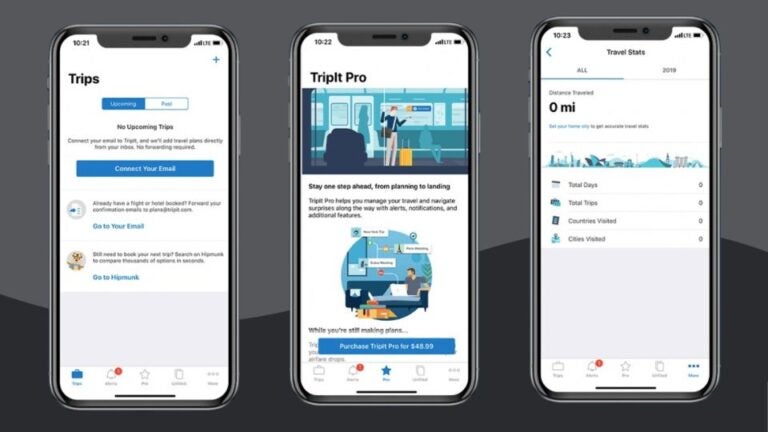How to make a travel itinerary: Step-by-step guide
Master the art of travel planning without losing your mind. This step-by-step guide helps you create an organized, flexible itinerary that won’t leave you sprinting through airports.
You’ve booked your flights, maybe a hotel or two, and now the fear of missing out kicks in — so much to do, so much to see, so little time to explore your destination.
What are you actually going to do during your stay abroad?
A detailed itinerary keeps your entire trip organized, highlights top attractions, and prevents those “Wait, what was the name of that place again?” moments.
Whether you’re traveling for leisure or a business trip, this step-by-step guide will help you create an itinerary that covers all the details for your next adventure.
Main components of a travel itinerary
An itinerary is your travel storybook, with all the details about how you’re getting from point A to point B, and all the exciting adventures and pit stops in between.
It’s like having a trusty guide that ensures every moment of your journey is planned out. Here’s what you need to keep in mind for your travel planning process:
- Travel dates and times: Start with the basics: your travel dates, flight numbers, departure times, layover information and return dates.
- Hotel reservations and accommodation details: Write down where you’re staying — hotel names, addresses, check-in/check-out times, and booking confirmations. Because “I think it’s near that one coffee shop” isn’t going to help at midnight.
- Transportation info: How are you getting around? Include car rentals, public transport schedules, or rideshare details. Add departure times and pick-up points.
- Daily activities and destinations: Plan your days with specific locations, top attractions, and points of interest. Check opening hours — because showing up to a closed museum is a rite of passage we can skip. Add local events if your upcoming trip overlaps with festivals or markets.
- Emergency contacts: You hope you’ll never need this, but it’s better to be prepared. List emergency contacts like local emergency services, your embassy, and someone back home who answers your texts faster than “seen.”
- Budget and expenses: Use a trip planning app to log expenses, or just go old school with Excel sheets.
- Reliable internet for international travel: And don’t forget about roaming fees from your phone carrier. They sneak up fast, especially if you rely on your home carrier. Save yourself the headache (and the bill shock) by grabbing a Holafly eSIM. Get unlimited data in over 200 destinations, skip your carrier’s roaming fees, and only pay for what you need.
Now that we’ve covered the essentials, it’s time to get down to business and learn how to actually create a travel itinerary.
How to make an itinerary
Whether you’re planning a road trip, a business trip, or a month-long adventure, these steps will help you stay organized and maximize your travel experience.
1. Set your travel dates
First things first — lock in your travel dates. Knowing your departure and return dates helps with booking flights, hotel reservations, and planning activities.
Keep in mind that some places are best visited during specific seasons.
For example, if you’re heading to Japan, cherry blossom season in spring is a must. Visiting Europe? Summer means longer days but bigger crowds, while winter offers the best Christmas markets.
2. Set your budget
Next, figure out how much you can spend for your entire trip. You should also keep a little extra set aside for emergencies (because you never know).
A good way to allocate your travel budget is:

- 30% Flights
- 25% Accommodation
- 20% Food & Activities
- 10% Local Transportation
- 10% Emergencies & Travel Insurance
- 5% Extras & Shopping
For example, if you’ve got $3,000 USD set aside for your trip, a good breakdown would be $900 for flights, $750 for accommodation, and $600 for food and activities.
That means you’ll have $300 for local transportation, $300 set aside for emergencies or travel insurance, and $150 for extras like souvenirs or last-minute experiences.
Next, break down costs by category. Use a spreadsheet, Google Sheets, or a trip planning app to track expenses by category:
- Transportation: This includes flights, car rentals, trains, and local transit. Flying to Europe? Budget around $800 for round-trip tickets. Renting a car for a road trip in the U.S.? Expect $40–$70 per day plus gas.
- Accommodation: Compare hotels, hostels, or vacation rentals. A budget hotel in Thailand might cost under $20 per night, while a mid-range hotel in Paris could be $150 per night.
- Daily spending: Plan $50–$100 per day depending on your destination. Think meals, entry fees to top attractions, and souvenirs.
- Activities: Prioritize free or low-cost experiences like museums or parks, and splurge on one or two big-ticket items — maybe a hot air balloon ride in Cappadocia or a Broadway show in NYC.
2. Choose your destinations
Start by identifying what excites you. Are you into history, food, nature, or city life? If you love museums and architecture, cities like Paris or Mexico City are perfect.
Prefer nature? Think about Iceland’s waterfalls or the jungles of Costa Rica. And don’t feel obligated to hit every “must-see” spot — if you’d rather skip the Eiffel Tower and spend your time in Parisian cafés, do it. Your trip, your rules.
Next, consider practical details. How much time do you have? A weekend might be perfect for a quick city break, while a two-week road trip allows you to explore multiple destinations.
For example, if you’re wondering where to travel in November, consider destinations like Japan for autumn foliage or Morocco for mild, pleasant weather.
Make sure your travel plans align with your financial limits. And if you’re heading overseas, factor in visas, travel insurance, and even what to pack for international travel.
Finally, think about logistics and pacing—trying to squeeze in too much can leave you feeling more exhausted than excited.
Instead of cramming multiple cities into a short trip, focus on one or two key destinations where you can truly immerse yourself.
3. Research and map out your route
Once you’ve picked your destinations, it’s time to figure out how you’re getting from point A to point B — and what you’ll do along the way.
For road trips or multiple destinations, mapping out your route helps you plan the best route between cities or landmarks.
Tools like Rome2Rio can show you local maps and whether it’s faster (or cheaper) to drive, take a train, or catch a bus between locations.
4. Plan your daily activities
It’s tempting to pack your travel itinerary with every attraction under the sun, but less is more.
Aim for 2–3 must-see attractions a day, and leave space for those unexpected finds — a street performance, a tucked-away café, or just time to relax without rushing from one landmark to the next.
Open Google Maps and start dropping pins. This helps you visualize the layout of your trip and group nearby activities together.
If you’re visiting Rome, for example, you can plan to see the Colosseum, Roman Forum, and Palatine Hill all in one day since they’re within walking distance.
Structure your days around points of interest that make sense together. Instead of racing across town, focus on one area at a time. And don’t forget to double-check opening hours, factor in public transport delays, and leave room for downtime.

5. Book your flights, accommodation, and transport
Use flexible date searches to find the best flight deals, consider flying midweek when prices tend to dip, and keep an eye on seasonal trends.
For example, if you want to travel in December, flights to tropical destinations might skyrocket during winter holidays, while the best places to go in August will be impacted by school summer vacations in the Northern Hemisphere.
Then, find the perfect stay. Whether you’re after cozy apartments, chic city lofts, or beachfront villas, the best vacation rental sites like Airbnb, Vrbo, and Booking.com have you covered.
If you prefer something with a personal touch, check out local guesthouses or boutique hotels.
Finally, figure out how you’ll get from place to place. For road trips or exploring off-the-beaten-path destinations, car rentals are the way to go — just double-check if you need an international driver’s license. If you’re city-hopping, look into trains, buses, or even budget airlines.

6. Organize, save, and share your trip details
Now, it’s time to pull everything together into one easy-to-access spot. Apps like TripIt or Wanderlog can organize everything into a single view.
Prefer the DIY route? Use Google Sheets or Microsoft Excel to list your travel dates, departure times, and specific locations.
And if you’re traveling with friends or family, share your itinerary using Google Docs — so everyone stays on the same page, literally.

7. Grab an unlimited data eSIM
Whether it’s pulling up Google Maps when you’re lost in a new city, double-checking hotel reservations, or quickly translating a menu, you need to stay connected to the internet.
And if you’ve ever been hit with sky-high roaming fees from your home carrier, you know it’s not a mistake you want to repeat.
That’s why an eSIM provider like Holafly is a good choice. With coverage in 200+ destinations, you can travel the world confidently without worrying about surprise charges or hunting for WiFi.
Traveling across multiple countries? Holafly’s got regional plans for places like Asia and Europe, so you don’t have to switch SIM cards at every border crossing.
Plus, you can customize your plan based on how long you’re traveling — anywhere from 1 to 90 days. If you’re heading on a global adventure, Holafly Connect’s monthly eSIM subscription gives you access to worldwide destinations, unlimited data, unlimited hotspot, and peace of mind as you travel.
Tips to create a personalized itinerary
Planning the basics is one thing, but making an itinerary yours? That’s where the fun begins. Here’s how to fine-tune your plans without turning your vacation into a rigid checklist.
- Cluster destinations geographically: Don’t zigzag across a city like you’re in a game of pinball. Use Google Maps to group attractions by neighborhood — think Kyoto’s temples or Barcelona’s Gaudí sites. This keeps your trip efficient and your feet happy.
- Balance structure and spontaneity: Sure, book that must-see museum or a bucket-list dinner, but leave afternoons open for whatever catches your eye. We swear by 2–3 activities per day to keep things chill, not chaotic.
- Use tech tools for efficiency: AI itinerary generators like Mitrip or collaborative Google Sheets help keep your plans tight and organized, especially when traveling with others.
- Match your itinerary to your interests: Love street food? Map out the best ramen spots in Tokyo. Into hiking? Prioritize Patagonia’s trails. Tailor your trip around what excites you, not just what the guidebooks say.
- Customize based on your travel style: Whether you’re a seasoned traveler or planning your first big trip, make sure your itinerary reflects how you like to explore — fast-paced or slow and immersive.
Stay connected during your adventure, with Holafly
And there you have it — a step-by-step guide to crafting a travel itinerary that’s as organized as it is flexible. Hopefully, this article gave you a head start on organizing your next adventure.
And while you’re at it, don’t forget to grab a Holafly eSIM. With unlimited data in over 200 destinations, you’ll stay connected without worrying about roaming fees or juggling SIM cards.
Plus, if you ever hit a snag, Holafly’s 24/7 customer support on WhatsApp (available in 10+ languages) has your back.
That’s one less thing on your to-do list — now go plan that dream trip!





 Language
Language 


















 No results found
No results found












